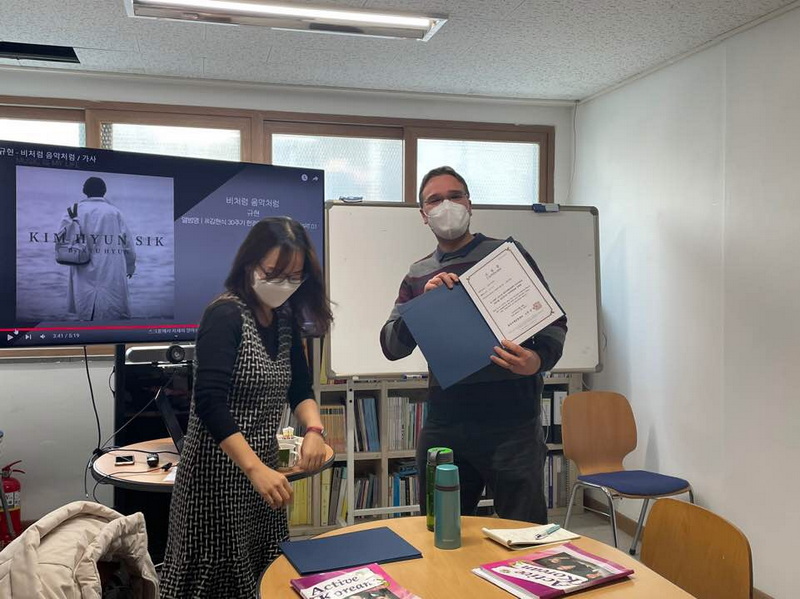Flipping the Classroom: Walking in Students’ Shoes
By Chris Judd
On returning in January 2021 from a two-year stint back home in England, I noticed my Korean language skills had seriously faded. The frustration of struggling to find words again told me loud and clear: This language learning fossil needed an urgent booster shot of Korean.
An internet search for available Korean language classes in Gwangju revealed only a couple of viable options: language exchange by Zoom or a face-to-face class at the Gwangju International Center (GIC). Having had quite enough of Zooming of late, the GIC class it had to be. Fortunately, the application process was very smooth, consisting of a simple, self-administered level test from the GIC website and then selecting a time that suited me. The GIC staff were quick to reply by email and managed to squeeze me in at the last minute to join a Saturday class.
It was from here on that the lessons really began, but not just in terms of studying Korean. I quickly realized that this experience would provide a great opportunity to pick up some teaching tips and insights along the way. I had flashbacks to why I fell in love with teaching as a new EPIK teacher in Pohang back in 2012. It was while learning Korean in classes at POSTECH, and at language exchange meetups in cafes, that I experienced what fun and power there was in learning a language. This realization energized my teaching practice and eventually made me join Korea TESOL to help develop my craft.
Lesson 1: First Day Nerves
After packing my bag in the morning, as I approached the GIC, the old familiar first lesson nerves kicked in. Who would be in my class? How would the teacher be? Having not been a student for some time, this gave me a good chance to empathize with how the students in my English classes at Chosun University must feel. Luckily, the class had a relaxed vibe, so after a quick round of self-introductions, everyone in the class quickly settled. This must be a nervous time for freshman, too, so this was a reminder to be especially kind and patient in those first lessons of the semester.
Lesson 2: Be Understanding of Your Students
On the morning of the first lesson, I made a string of rookie errors – far from ideal when you are a teacher and know the value of making a good first impression with your new teacher and classmates. Having signed up at the last minute, not yet having bought the textbook, and never having been to the GIC before, I left myself too much to do. Having parked the car a fair distance away, I speed-walked to the GIC, planning to visit a nearby bookshop to get the textbook on route. First problem, the bookshop was closed. After this setback and deciding that I would pop out at the break to get the book, I carried on to the GIC. Second problem, it was much further than I had thought, and I was walking down the wrong road. After all this, I finally arrived at the classroom, almost 15 minutes late and somewhat disheveled. Luckily, the teacher was very welcoming, greeting me kindly with “Finally a male student!” and arranged for photocopies of the book for those without for the first lesson. This warm welcome reminded me to be mindful of our students’ current circumstances; they may just be having a bad morning when they arrive late without the required materials.

Lesson 3: Make Visual Materials Simple
Once lessons were underway, I felt the importance of another crucial part of second language lessons from the student perspective: keeping visual materials simple. Our teacher used very effective PowerPoint presentations with simple and clear examples of target expressions and nice photos. Compared to the textbook examples, these PowerPoints were a lot easier to make sense of and something we could use as a bridge to making our own examples in pair work, which we were frequently encouraged to do. This personalizing of expressions was also a lot more fun for us students than simply going through the book.
Lesson 4: Make Some Time for Fun and Relaxation
The last tip I picked up was to do something that is pure fun and not learning-focused at all. As we finished the course the week before Christmas, the teacher prepared a cookie decorating activity. It was during this time that we got to practice the most free-flowing, spontaneous conversations in Korean, with the cookie decorating turning into a sideshow.

So, overall, I got much more than the booster shot of Korean I had bargained for. I got a healthy reminder of how students experience lessons and some great reminders of tips to take into my classroom for the coming semester. If you are looking to take a Korean language class, I wholeheartedly recommend the GIC lessons; you may just benefit your teaching skills, too.
Photographs by Chris Judd.
The Author
Chris Judd is an ESL teacher and researcher who returned from his native UK to live in Gwangju in 2021. He has lived in five different cities in Korea over an eight-year period, enjoying learning a bit of the language and getting out and about on family trips along the way.







